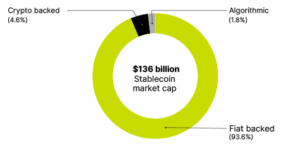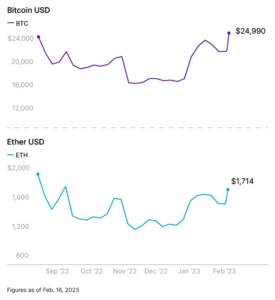Here Comes Crypto Spring

Pedestrians walk past a display of cryptocurrency Bitcoin on February 15, 2022 in Hong Kong, China. Cryptocurrencies are gaining popularity worldwide as investors seek to diversify into the new asset class despite wild swings in the valuations of assets like Bitcoin and Ethereum.
Photo: Anthony Kwan/Getty Images
Bankruptcies, fraud allegations, perp walks, trillions of dollars in lost value: The past year has been terrible for cryptoasset markets. But it doesn’t mean the end of digital asset innovation. In fact, signs that crypto winter is giving way to spring are already appearing. Further, much of the digital asset ecosystem continued forward in 2022, largely unaffected by the well-publicized disasters.
The collapse of Sam Bankman-Fried’s FTX exchange and other debacles revealed major flaws in the business models and practices of many crypto ventures. But they did not reflect fundamental weaknesses in the industry’s underlying technology or its ability to transform many areas of financial services. The challenge now is to focus on that promise, identify and rectify the flaws, and develop rules of the road that offer protections for investors while fostering truly valuable innovation.
How will that play out going forward? In a new paper, the Oliver Wyman Forum contends that development activity will continue apace or accelerate in areas largely untouched by the blowups of 2022, such as payment vehicles like stablecoins and central bank digital currencies (CBDCs), and decentralized finance (DeFi), which is attracting growing interest from crypto natives and traditional financial institutions. At the same time, areas that were at the heart of the market meltdown, notably exchanges and crypto lending, will need significant reforms to satisfy regulators and regain investors’ full confidence. And investment interest in cryptoassets looks set to continue but remain volatile.
For digital assets, such as Bitcoin, that don’t represent a claim on any underlying financial asset in the way that stocks or bonds do, future prices will depend as much on market sentiment, interest rates, and other macroeconomic factors as on crypto-specific issues.
Sorting Through the Wreckage
Last year’s string of debacles, which began with the collapse of the Terra-Luna stablecoin system in May and culminated with the failure of FTX and its trading arm, Alameda Research, in November, resembled a crypto version of the 2007-08 financial crisis. At the market’s nadir, the value of all cryptocurrencies was around $780 billion, down more than 70% from the peak a year earlier.
Yet those losses shouldn’t obscure the many promising areas of digital asset activity that are attracting growing interest from digital native firms, established financial institutions, and governments.
Transforming Payments and Capital Markets
One of the most promising areas is the future of money itself. Stablecoin trading volume has increased in line with cryptoasset prices this year, and these coins could get a further boost if governments adopt regulations to require them to be backed by reserves of high-quality fiat assets such as the dollar or euro. The European Union will require such backing as part of its Markets in Crypto-Assets (MiCA) regulation, which is expected to be approved this spring, and policymakers around the globe — including in the United States, United Kingdom, and Hong Kong — are considering similar steps.
Fiat Reserves Dominate in Stablecoins
Big banks, meanwhile, are looking to secure their role in digital payments by using blockchain technology to turn deposits into tradeable tokens. By combining a well-known instrument from regulated institutions with blockchain technology, deposit tokens can support a variety of domestic and cross-border payments, according to a new report by Oliver Wyman and Onyx by J.P. Morgan. Governments also are stepping up their exploration of central bank digital currencies, or CBDCs, with the UK launching a consultation on the creation of a digital pound and the European Central Bank planning to decide on a digital euro later this year.
Recent crypto failures also haven’t deterred institutions from exploring ways to transform capital markets with blockchain technology. In a recent paper with Singapore’s DBS, Onyx by J.P. Morgan, and SBI Digital Assets Holdings, the Oliver Wyman Forum showed how institutions could carry out foreign exchange and government bond transactions on a public blockchain using adapted DeFi software protocols, with regulated institutions verifying the credentials of participating entities. Institutional DeFi, as we call it, could dramatically enhance the speed and efficiency of traditional markets. Firms and the industry at large will need to develop common standards and frameworks to scale this activity and unleash those benefits.
Closer Regulatory Scrutiny
Other parts of the digital assets ecosystem will need major reform to recover and prosper, driven both by regulators and industry players. That is clearly the case for exchanges and lending vehicles. FTX’s massive loans to its related trading arm, Alameda Research, brought both entities down and are at the heart of the fraud charges against Bankman-Fried. Lenders like Celsius offered high yields to new clients by using existing customers’ cryptoassets as collateral against other lending opportunities.
Policymakers are already moving to address abusive practices through legislation and threats of enforcement action. The EU’s MiCA bill will require service providers like exchanges to comply with rules against money laundering, market manipulation, and insider trading, and make them liable if they lose investors’ assets. The US Securities and Exchange Commission has just proposed extending custody rules to crypto assets to ensure they are protected in case of a business failure. Regulators also are likely to crack down on commingling of funds and to adopt rules to control potential conflicts from combining multiple activities, such as running an exchange and a hedge fund under one roof. And we can expect major jurisdictions to put greater pressure on countries that take a lax approach to crypto to attract business.
Crypto Prices on the Rebound
Crypto Investment
Finally, investment interest in Bitcoin, Ether, and many other cryptoassets looks set to continue but remain volatile. The broad cryptoasset market has risen by more than 40% this year, as of Feb. 16, and Bitcoin is up 50%, but both remain nearly two thirds below the all-time highs of late 2021. For digital assets, such as Bitcoin, that don’t represent a claim on any underlying financial asset in the way that stocks or bonds do, future prices will depend as much on market sentiment, interest rates, and other macroeconomic factors as on crypto-specific issues.
The Road Ahead
The process of cleaning up crypto is unlikely to be smooth. Some cryptoasset enthusiasts have a strong libertarian streak and seek to position crypto as an alternative to conventional finance. But the gains from fixing the industry’s flaws and adapting the underlying technology to the world’s trillion-dollar markets for stocks, bonds, and other assets should prove too great to resist. Not surprisingly, the largest digital asset firms have embraced calls for sensible regulation.






